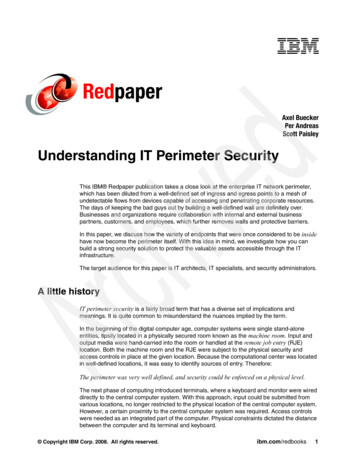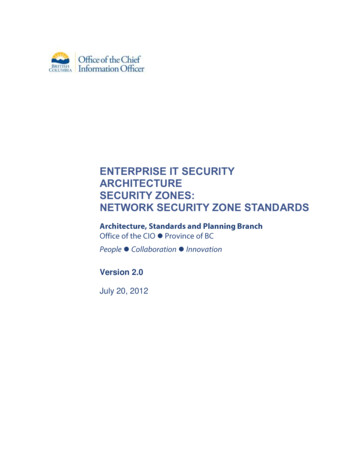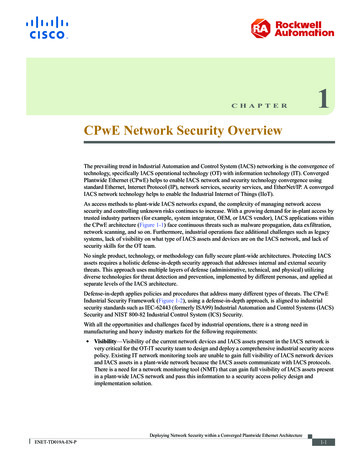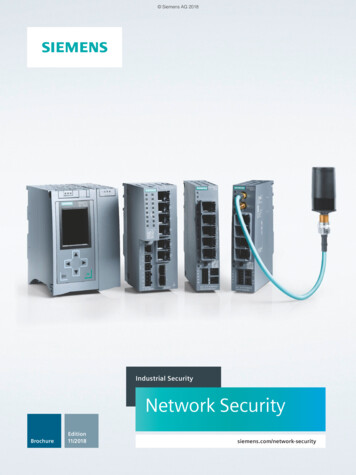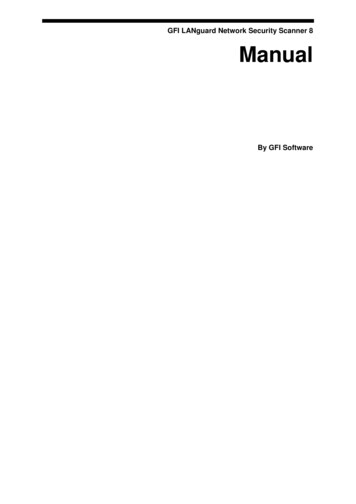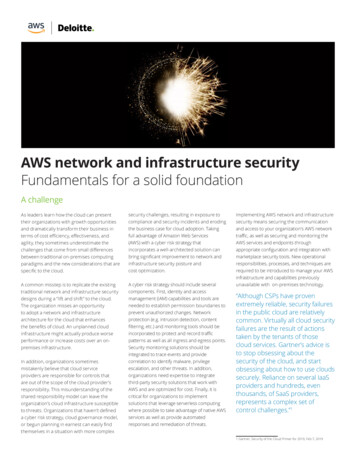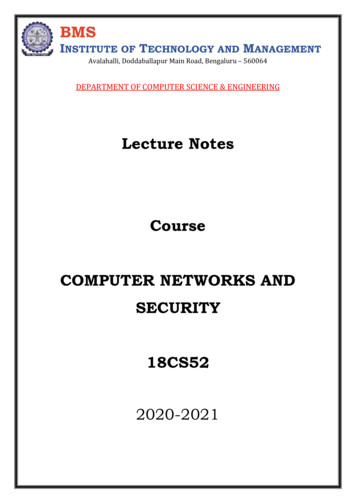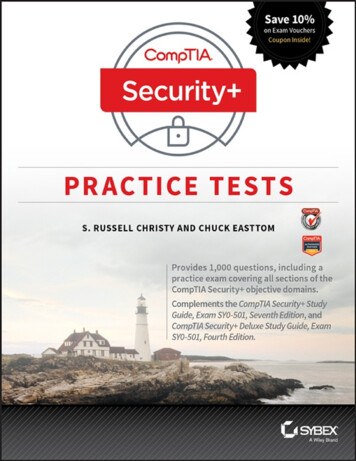
Transcription
Outline Firewalls– Routers– Proxies– ArchitecturesINF3510 Information Security Intrusion Detection SystemsLecture 11:Network Perimeter Security– Host-based– Network based– Dealing with false alarms Wireless LAN Access Control– Evolution & history– WPA2: Robust Security Network architecture (RNS)Audun JøsangUniversity of OsloSpring 2017L11: Perimeter SecurityPerimeter security analogyMedieval Castle DefencesObservationpostsGuardNetwork Perimeter SecurityExternal Network(DMZ)Inner wallGatehouseFirewallNormalOutercourtProduction WorkServers StationsFirewallInternet accessGatewayRouter &Packet FilterMoatUiO INF3510 - Spring 2017Internal NetworkDNSMail WebServer Server ServerInnercourtBridge2Defending local networksOuter wallNormal accessL11: Perimeter SecurityUiO INF3510 - Spring 2017SwitchHoneypot3L11: Perimeter SecurityChokeRouter,ProxyIDSUiO INF3510 - Spring 2017SwitchIDSDB4
Workshop Lab topology (later)FirewallsL11: Perimeter SecurityUiO INF3510 - Spring 20175Network perimeter security method:FirewallsFirewalls: Overview 1 If the risk of having a connection to the Internet isunacceptable, the most effective way of treating the riskis to avoid the risk altogether and disconnect completely. If disconnection from the Internet is not practical, thenfirewalls may provide an effective level of protection thatcan reduce the risk to an acceptable level. Firewalls are often the first line of defence againstexternal attacks, but should not be the only defence. A firewall’s purpose is to prevent unauthorized access toor from a private network. A firewall is a check point that protects the internalnetworks against attack from outside networks The check point decide which traffic can pass in & outbased on rulesExternal NetworkPotential ThreatsInternalResourcesInternetFirewall Check PointL11: Perimeter SecurityUiO INF3510 - Spring 20177L11: Perimeter SecurityUiO INF3510 - Spring 20178
Types of Firewall Technology (vehicle analogy)Firewalls: Overview 2 Router Packet Filters All traffic entering or leaving must pass through firewall The network owner must define criteria for what is(un)authorized The effectiveness of firewalls depends on specifyingauthorized traffic in terms of rulesABC123Analysesbi-directional traffic Stateful Packet Filters– The rules defines what to let pass through;– The rules defines what to block. Application Layer Proxy Firewalls must be effectively administered, updated withthe latest patches and monitored. Firewalls can be implemented in both hardware andsoftware, or a combination of both.L11: Perimeter SecurityInspects packetheaders onlyUiO INF3510 - Spring 2017 Next Generation Firewall9L11: Perimeter SecuritySplits connection,inspects payload, andanalyses trafficEnd-to-end connectioninspects payload, andanalyses trafficUiO INF3510 - Spring 201710Router-based Packet Filter A packet filter is a network router that can accept/rejectpackets based on headers Packet filters examine each packet’s headers and makedecisions based on attributes such as:Simple Packet FilterStateful Packet FilterProxyNext Gen.Firewall–––––Source or Destination IP AddressesSource or Destination Port NumbersProtocol (UDP, TCP or ICMP)ICMP message typeAnd which interface the packet arrived on Unaware of session states at internal or externalhosts High speed, but primitive filterL11: Perimeter SecurityINF3510 - Spring 2017Application ProxyUiOFirewallNext Generation Firewall11L11: Perimeter SecurityUiO INF3510 - Spring 201712
Host-based Packet FiltersStateful Packet Filters A host can also perform packet filtering, in addition toperforming other host tasks such as web serving Stateful packet filters track current state of a connection– More ‘intelligent’ than simple packet filters.– in this case the packet filter is designed to protect the host itself,not other hosts on the network Common packet filter software includes:– IPChains for Linux (superseded)– TCP Wrappers for various Unix– IP Filter for Sun Solaris Stateful packet filters keep track of sessions– Recognise if a particular packet is part of an establishedconnection by ‘remembering’ recent traffic history.– Will add a temporary rule to allow the reply traffic back throughthe firewall.– When session is finished, the temporary rule is deleted. This makes the definition of filtering rules easier toaccomplish and therefore potentially more secure. High speed, can use relatively advanced filter rules Requires memory– So can be subject to DOS (Denial of Service) attacksL11: Perimeter SecurityUiO INF3510 - Spring 201713L11: Perimeter SecurityUiO INF3510 - Spring 201714Packet Filter Strengths and WeaknessesPersonal Firewalls Strengths: A personal firewall is a program that is designed toprotect the computer on which it is installed. Personal firewalls are frequently used by home users toprotect themselves from the Internet. Personal firewalls are usually a stateful packet filter. Some products include anti-virus software as well(usually at extra cost).– Low overhead and high throughput– Supports almost any application Weaknesses:– Unable to interpret application layer data/commands may allow insecure operations to occur– Allows direct connection between hosts inside &outside firewall– Non-stateful packet filters only: primitive and moredifficult to write complex rulesL11: Perimeter SecurityUiO INF3510 - Spring 2017– Vendors such as ZoneAlarm, and Sygate provide a free versionof their product for personal use.– Windows clients and Windows servers ship with InternetConnection Firewall (ICF).15L11: Perimeter SecurityUiO INF3510 - Spring 201716
IPv4 Network Address Translation (NAT) NAT used to increase IPv4 address space Each local network can reuse private IP address ranges– Artificially increases the number of usable IP addresses Possibilities:– Static mapping permanent mapping of public to private address (no gain)– Dynamic mapping mapping of public to private address when needed unmapped when no longer needed– PAT (Port Address Translation) multiple internal addresses mapped to same public address butwith different port numbersL11: Perimeter SecurityUiO INF3510 - Spring 201717Application Layer Proxy4L11: Perimeter Security21ProxyUiO INF3510 - Spring 2017––––Helps enforce control over outbound connectionsHelps restrict incoming trafficHelps conceal internal network configurationMakes port scanning more difficult Can’t be used with:––––protocols that require a separate back-channelprotocols that encrypt TCP headers such as IPSecembedded TCP address info(Not recommended with) IPv6L11: Perimeter SecurityUiO INF3510 - Spring 201718 Inspects payload in end-to-end or proxy application connection Support specific application protocols– e.g. http, telnet, ftp, smtp etc.– each protocol supported by a specific proxy HW/SW module Can be configured to filter specific user applications– E.g. Facebook, Youtube, LinkedIn– Can filter detailed elements in each specific user application Can support TLS/SSL encrypted traffic inspection Can provide intrusion detection and intrusion prevention Very high processing load in firewallApplicationLayer FirewallClient AdvantagesNext Generation Firewalls (NGFW)1. External client sends a request to the server, which isintercepted by the outwards-facing firewall proxy2. Inwards-facing proxy sends request to server on behalf of client.3. Server sends reply back to inwards-facing firewall proxy.4. Outwards facing proxy sends reply to the client. Client and server both think they communicate directly with eachother, not knowing that they actually talk with a proxy. The proxy can inspect the application data at any level of detail,and can even modify the dataInternetIPv4 NAT: & -– High volume needs high performance hardware, or else will be slowServer319L11: Perimeter SecurityUiO INF3510 - Spring 201720
High performance NGFWsInline Deep Packet Inspection Deep Packet Inspection looks at application contentinstead of individual or multiple packets. Deep inspection keeps track of application contentacross multiple packets. Potentially unlimited level of detail in traffic filteringHigh range model: PA-7050Up to 120 Gbps throughputPrices starting from: US 200,000Application parameters for e.g. FacebookDeep InspectionPayload DataPayload DataPayload DataHigh range model: 61000 Security systemUp to 400 Gbps throughputPacket 1Prices starting from: US 200,000L11: Perimeter SecurityUiO INF3510 - Spring 201721TLS/SSL encrypted traffic inspection in firewalls TLS designed for end-to-end encryption, normally impossible to inspect In order to inspect TLS, proxy must pretend to be external TLS server Proxy creates proxy server certificate with the name of external server(e.g. facebook.com), signed by local proxy root private key Assumes that local proxy root certificate is installed on all local hosts The proxy server certificate is automatically validated by local client, souser may believe that he/she has TLS connection to the external server1Proxy BTLS BAuto- 54validation Client AProxy cert. B, Name C,of cert.signed by proxy rootL11: Perimeter Security2TLS C3UiO INF3510 - Spring 2017IP HeaderL11: Perimeter SecurityUDP HeaderUDP HeaderUDP HeaderPayload DataPayload DataPayload DataUiO INF3510 - Spring 201722Application Proxy Firewalls & Strengths:– Easy logging and audit of all incoming traffic– Provides potential for best security through control of applicationlayer data/commands Weaknesses:– May require some time for adapting to new applications– Much slower than packet filters– Much more expensive than packet filtersInternet PKIroot certificatesProxy rootcertificateIP HeaderPacket 2Packet 3IP HeaderServer CCert. C, Name C, signedby a CA in Internet PKI23L11: Perimeter SecurityUiO INF3510 - Spring 201724
TLS inspection attack with rogue proxy server Depending on network, attackers may be able to install rogue proxy Rogue TLS inspect does not assume pre-installed proxy root certificate Proxy creates fake server certificate with the name of external server(e.g. facebook.com), that e.g. can be self-signed Fake server certificate is not validated, so browser asks user to accept it Fake certificate has (name domain dame), so browser sets up TLS,and user believes that he/she has TLS connection to the external server5Internet PKIPop-up askingRogueroot certificateuser to acceptproxy R2certificate1User AcceptTLS CTLS R 7Server CCert. 634Client ACert. C, Name C, signedFake cert. R, Name C,8by a CA in Internet PKIsigned by proxy RBrokensecurityL11: Perimeter SecurityUiO INF3510 - Spring 201725Lenovo and the Superfish scam Superfish root certificate and diversion in shipped Lenovo models during 2014 All https connections diverted to Superfish server to inject advertisements. Superfish created fake server certificates with names of web servers(e.g. facebook.com), signed by Superfish root private key. Fake server certificates were automatically validated, so users believed thathe/she had secure end-to-end https connection to the web server. Scam discovered in 2015, Superfish cert. deleted and diversion removed. Embarrassment for Lenovo. Superfish changed name to JustVisual.Internet PKIroot certificatesSuperfishrootcertificate5Client A21Superfish cert, Name C,Cert. C, Name C, signedAutosigned by Superfishby a CA in Internet PKIvalidation&L11:brokenPerimeter SecurityUiO INF3510 - Spring 201726securityFirewalls:DMZ Firewall ArchitectureFirewalls:Simple Firewall ateway and ChokeRouter FirewallDMZ (Demilitarized Zone)Internal NetworksServer CTLS C3TLS S4Internal NetworksWorkstationsProduction DBSystems ServerChokeRouterFirewallDNSServerWebServerL11: Perimeter SecurityEmailServerWorkstationsUiO INF3510 - Spring 2017ProductionDBSystems Server27DNSWebEmailServer Server ServerL11: Perimeter SecurityInternal NetworksUiO INF3510 - Spring 201728
DMZ Example DMZ A part of your LAN with other restrictions, e.g.allowing publicly available services (web servers, mail l PublicNetwork/ INTERNETL11: Perimeter SecurityIntrusion Detection SystemsDMZInternal PrivateNetwork / LANUiO INF3510 - Spring 201729Intrusion Detection and PreventionIntrusion Detection Systems: IDS are automated systems that detect suspicious activity IDS can be either host-based or network-based. A host based IDS is designed to detect intrusions only onthe host it is installed onIntrusion– Actions aimed at compromising the security of a target network(confidentiality, integrity, availability of resources) Intrusion detection– monitor changes to host’s OS files and traffic sent to the host– The identification of possible intrusion through intrusionsignatures and network activity analysis– IDS: Intrusion Detection Systems Network based IDS (NIDS) detect intrusions on one ormore network segments, to protect multiple hosts– monitor network/s looking for suspicious traffic What can be detected:Intrusion prevention– The process of both detecting intrusion activities and managingautomatic responsive actions throughout the network– IPS: Intrusion Prevention Systems– IDPS: Intrusion Detection and Prevention SystemsL11: Perimeter SecurityUiO INF3510 - Spring 201731– Attempted and successful misuse, both external and internal agents– Malware: Trojan programs, viruses and worms– DOS (Denial Of Service) attacksL11: Perimeter SecurityUiO INF3510 - Spring 201732
Network IDS DeploymentIntrusion Detection TechniquesGateway RouterFirewall Misuse detection– Use attack “signatures” (need a model of the attack)Internet Sequences of system calls, patterns of network traffic, etc.ChokeFirewallDMZ NetworkDB ProductionWorkServerServerStation– Must know in advance what attacker will do (how?)– Can only detect known attacks– Relatively few false positives Anomaly detection– Using a model of normal system behavior, try to detectdeviations and abnormalitiesDNSWebServer ServerEmailServerInternal NetworksNIDS E.g., raise an alarm when a statistically rare event(s) occurs– Can potentially detect unknown attacks– Many false positivesNIDSL11: Perimeter SecurityUiO INF3510 - Spring 201733L11: Perimeter SecurityUiO INF3510 - Spring 2017Popular NIDSPort Scanning Snort (popular open-source tool) Many vulnerabilities are OS-specific– Large rule sets for known vulnerabilities, e.g. 2009-03-31: A programming error in MySQL Server may allow a remoteattacker to cause a Denial of Service (DoS) against a vulnerable machine. 2009-03-27: Microsoft Windows GDI Buffer Overflow: A programming error inthe Microsoft Windows kernel may allow a remote attacker to execute codewith system level privileges. This may be exploited when specially craftedEMF files are viewed using Microsoft Internet Explorer. Bro (developed by Vern Paxson)– Separates data collection and security decisions Event Engine distills the packet stream into high-level eventsdescribing what’s happening on the network Policy Script Interpeter uses a script defining the network’s securitypolicy to decide what to do in responseL11: Perimeter SecurityUiO INF3510 - Spring 2017slide 35slide 34– Bugs in specific implementations, default configuration Port scan is often a prelude to an attack– Attacker tries many ports on many IP addresses For example, looking for an old version of some daemon withan unpatched buffer overflow– If characteristic behavior detected, mount attack– “The Art of Intrusion”: virtually every attack involvesport scanning and password crackingL11: Perimeter SecurityUiO INF3510 - Spring 2017slide 36
Intrusion Detection ProblemsIntrusion Detection Errors Lack of training data with real attacks False negatives: attack is not detected– But lots of “normal” network traffic, system call data– Big problem in signature-based misuse detection Data drift False positives: harmless behavior is classified as attack– Statistical methods detect changes in behavior– Attacker can attack gradually and incrementally– Big problem in statistical anomaly detection Both types of IDS suffer from both error types Both false positives and false negatives are problematic Discriminating characteristics hard to specify– Many attacks may be within bounds of “normal” range of activities False identifications are very costly– Attacks are fairly rare events– IDS often suffer from “base-rate fallacy”– Sysadm will spend many hours examining evidenceL11: Perimeter SecurityUiO INF3510 - Spring 2017slide 37L11: Perimeter SecurityUiO INF3510 - Spring 2017slide 38Base Rate Fallacy Consider statements: r: “attack occurs”,s: “signature detected”p(r s): probability of attack, given that signature is detectedp(s r): probability of signature, given that attack occursp(s r) : probability of signature when no attack occursa(r): base rate of attacks (i.e. average rate of attack per connection) Training produces p(s r) and p(s r), but detection requires p(r s) Base rate fallacy is to assume p(r s‘ p(r s’ is a good approximation when a(r‘ p(r s’ is a bad approximation when a(r) 1 and p(s r) 0 Correct p(r s) requires a(r):L11: Perimeter SecurityUiO INF3510 - Spring 201739without considering a(r)L11: Perimeter Securityp( r s )or p(s ra(r ) p( s r )a (r ) p ( s r ) (1 a (r )) p( s r )UiO INF3510 - Spring 201740
Remarks on Intrusion DetectionHoneypots Most alarms are false positives– Requires automated screening and filtering of alarms A honeypot: Most true positives are trivial incidents– is a computer configured to detect network attacks or maliciousbehaviour,– appears to be part of a network, and seems to contain informationor a resource of value to attackers.– can be ignored,– the attacks will never be able to penetrate any system Serious incidents need human attention But honeypots are isolated, are never advertised and arecontinuously monitored All connections to honeypots are per definition malicious Can be used to extract attack signatures Honeynet is an international security club, see next slide– Can be dealt with locally– May require external expertise Potential for improvement through more intelligent IDS– Less false positives– Better detection of advanced attacks (APT)L11: Perimeter SecurityUiO INF3510 - Spring 2017slide 41L11: Perimeter SecurityUiO INF3510 - Spring 2017Intrusion Prevention Systems Intrusion Prevention System (IPS) is a relatively newterm that can mean different things Most commonly, an IPS is a combination of an IDS anda firewall A system that detects an attack and can stop it as well Can be application specificWLAN Security– Deployed on a host to stop attacks on specific applications suchas IIS Can be an extension of an NIDS False positives are problematic, because automatedprevention measures can block servicesL11: Perimeter SecurityUiO INF3510 - Spring 201743slide 42
802.11 WiFi SecurityIEEE 802.11 Standards for WLAN Only authorized terminals (or users) may get access through Wireless LAN Should be impossible to set up rogue AP Interception of traffic by radios within range should be impossible IEEE 802.11 formed in 1990’s– charter to develop a protocol & transmission specifications forwireless LANs (WLANs)WEP (1999) WPA (2003)WPA2 (2004) (aka. RSN)801.11b802.11i (subset) 802.11i (full set) Since then the demand for WLANs, at differentfrequencies and data rates, has exploded New ever-expanding list of standards issued– from 10Mbps to 1Gbps transmission rateInternetAccess Point(AP)L11: Perimeter SecurityUiO INF3510 - Spring 2017EAPEAPEncryptionRC4 TKIPCCMP AES CTR (or TKIP)–––––––WirelessStation (STA)WiFiSecurityAuth. & key gen. WEP45RC4WEP: Wired Equivalent Privacy (broken)WPA: WiFi Protected AccessEAP: Extensible Authentication ProtocolRC4: Rivest Cipher 4 (a stream cipher)TKIP: Temporal-Key Integrity ProtocolCCMP: Counter Mode with CBC Message Authentication ProtocolRSN: Robust Security NetworkL11: Perimeter SecurityUiO INF3510 - Spring 201746Network Components & ArchitectureIEEE 802 Terminology Station (STA)– Wireless terminal that communicates with 802.11 functionality Access Point (AP)– Receives radio signals and controls access to network Basic Service Set (BSS)– Set of stations and one AP Extended Service Set (ESS)– Set of multiple BSSs Distribution System (DS)– Contains an Authentication Server (AS)– Integrates multiple BSSs into one ESSL11: Perimeter SecurityUiO INF3510 - Spring 201747L11: Perimeter SecurityUiO INF3510 - Spring 201748
802.11i RSN Services and ProtocolsL11: Perimeter SecurityUiO INF3510 - Spring 2017802.11i RSN Cryptographic Algorithms49L11: Perimeter SecurityUiO INF3510 - Spring 201750802.11i WiFi Access Control1.2.3.4.Mutual identity request between STA and APMutual authentication between STA and AS.Derive pairwise master key (PMK) between STA and AP.Encrypt radio link and open port (connect) to network access Controlled port from AP to network– is closed (disconnected) before authentication– is open (connected) after successful authenticationAccess Point (AP)12WirelessStation(STA)L11: Perimeter SecurityUiO INF3510 - Spring 201751L11: Perimeter Security3Always2open port44 Controlled portSwitchUiO INF3510 - Spring 2017AuthenticationServer(AS)Local Network& Internet52
When you don’t control the WLANEnd of LectureThis lecture presented: Often you want to connect to a wireless LANover which you have no control, e.g. in café Options: Firewall techniques– If you can, connect securely (WPA2, 802.11i, etc.) Intrusion detection techniques Beware of SSL-stripping– If unsecured, connect to online resources securely: Use a VPN (Virtual Private Network)– IPSEC connection to home gateway– TLS/SSL connections to secure web server (with HSTS) WLAN Access– Be careful not to expose passwords– Watch for direct attacks on untrusted networksL11: Perimeter SecurityUiO INF3510 - Spring 201753L11: Perimeter SecurityUiO INF3510 - Spring 201754
Personal firewalls are usually a stateful packet filter. Some products include anti-virus software as well (usually at extra cost). – Vendors such as ZoneAlarm, and Sygate provide a free version of their product for personal use. – Windows clients and Windows servers ship
